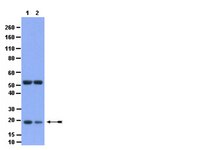AB2994 Sigma-AldrichAnti-Phospho-Bid (Ser65) Antibody
Anti-Phospho-Bid (Ser65) Antibody detects level of Phospho-Bid (Ser65) & has been published & validated for use in WB.
More>> Anti-Phospho-Bid (Ser65) Antibody detects level of Phospho-Bid (Ser65) & has been published & validated for use in WB. Less<<Produits recommandés
Aperçu
| Replacement Information |
|---|
Tableau de caractéristiques principal
| Species Reactivity | Key Applications | Host | Format | Antibody Type |
|---|---|---|---|---|
| H | WB | Rb | Affinity Purified | Polyclonal Antibody |
| References |
|---|
| Product Information | |
|---|---|
| Format | Affinity Purified |
| Control |
|
| Presentation | Purified in PBS with 0.09% NaN3. |
| Quality Level | MQ100 |
| Applications | |
|---|---|
| Application | Anti-Phospho-Bid (Ser65) Antibody detects level of Phospho-Bid (Ser65) & has been published & validated for use in WB. |
| Key Applications |
|
| Physicochemical Information |
|---|
| Dimensions |
|---|
| Materials Information |
|---|
| Toxicological Information |
|---|
| Safety Information according to GHS |
|---|
| Safety Information |
|---|
| Storage and Shipping Information | |
|---|---|
| Storage Conditions | Stable for 1 year at 2-8°C from date of receipt. |
| Packaging Information | |
|---|---|
| Material Size | 100 µg |
| Transport Information |
|---|
| Supplemental Information |
|---|
| Specifications |
|---|
| Global Trade Item Number | |
|---|---|
| Référence | GTIN |
| AB2994 | 04053252738913 |
Documentation
Anti-Phospho-Bid (Ser65) Antibody FDS
| Titre |
|---|
Anti-Phospho-Bid (Ser65) Antibody Certificats d'analyse
| Titre | Numéro de lot |
|---|---|
| Anti-Phospho-Bid (Ser65) - NG1580936 | NG1580936 |












